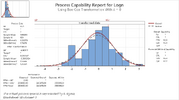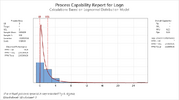Hello,
I have been searching throughout the internet for an answer to my questions but I can't quite find what I'm looking for. Looking through previous threads on this forum, I'm having a hard time understanding... I'm only a novice in statistics so forgive me.
I'm trying to assess the capability of various GD&T features such as true position, flatness, perpendicularity etc.
I'm supposed to calculate the Cpk and Ppk of the collected data from these features.
But does this make sense??
I thought the AIAG manual says that we have to assume normality and a two sided specification in order to calculate Cpk and Ppk?
From my understanding, data from true position/flatness etc will probably not be a normal distribution and it is not a two sided specification. Yoiu can't get past 0...also you want to get 0 as close as possible.
So with that in mind, how are Cpk and Ppk calculations done with these GD&T features?
Using the latest version of Minitab I can put 0 as the lower spec limit and select it as a hard boundary and I guess that can be used to calculate Cpk and Ppk in these situations?
I'm assuming I have to transform the data beforehand to normal distribution/select a different distribution model before doing that though. Will this give me something meaningful? I don't know if Minitab accounts for that when you select that lower boundary option.
Also does Ppk need to have a normally distributed data set in order to be accurate, or is that only for Cpk?
So many questions, I'm sorry.
I have been searching throughout the internet for an answer to my questions but I can't quite find what I'm looking for. Looking through previous threads on this forum, I'm having a hard time understanding... I'm only a novice in statistics so forgive me.
I'm trying to assess the capability of various GD&T features such as true position, flatness, perpendicularity etc.
I'm supposed to calculate the Cpk and Ppk of the collected data from these features.
But does this make sense??
I thought the AIAG manual says that we have to assume normality and a two sided specification in order to calculate Cpk and Ppk?
From my understanding, data from true position/flatness etc will probably not be a normal distribution and it is not a two sided specification. Yoiu can't get past 0...also you want to get 0 as close as possible.
So with that in mind, how are Cpk and Ppk calculations done with these GD&T features?
Using the latest version of Minitab I can put 0 as the lower spec limit and select it as a hard boundary and I guess that can be used to calculate Cpk and Ppk in these situations?
I'm assuming I have to transform the data beforehand to normal distribution/select a different distribution model before doing that though. Will this give me something meaningful? I don't know if Minitab accounts for that when you select that lower boundary option.
Also does Ppk need to have a normally distributed data set in order to be accurate, or is that only for Cpk?
So many questions, I'm sorry.



